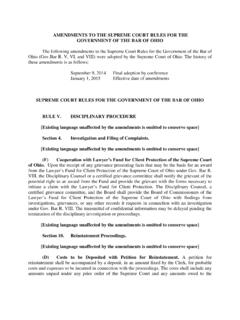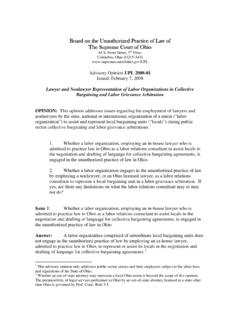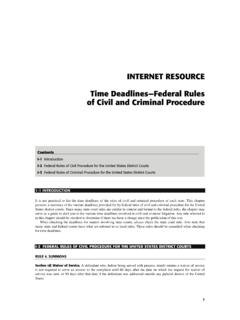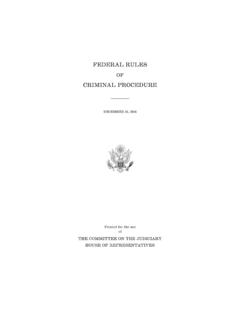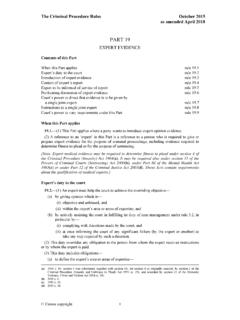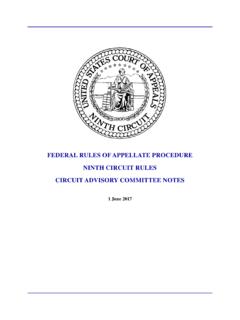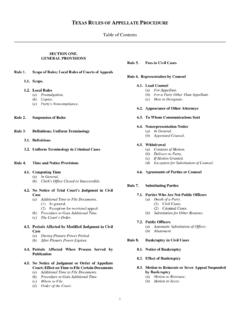Transcription of AMENDMENTS TO THE OHIO RULES OF CIVIL PROCEDURE, THE OHIO ...
1 AMENDMENTS TO THE ohio RULES OF CIVIL PROCEDURE, THE ohio RULES OF criminal PROCEDURE, THE ohio RULES OF EVIDENCE, AND THE ohio RULES OF JUVENILE PROCEDURE The Supreme Court of ohio has adopted the following AMENDMENTS to the ohio RULES of CIVIL Procedure (4, 5, 10, 19, 37, 54, 65 and 86), the ohio RULES of criminal Procedure (16 and 59), the ohio RULES of Evidence (601, 803, and 1102) and the ohio RULES of Juvenile Procedure (20 and 47). Authority: The AMENDMENTS are adopted by the Supreme Court pursuant to Article IV, Section 5(B) of the ohio Constitution, and were proposed by the Commission on the RULES of Practice and Procedure in ohio Courts pursuant to the document styled Process for Amending the RULES of Practice and Procedure in ohio Courts as set forth on the following page. Staff Notes: A Staff Note follows each amendment. Staff Notes are prepared by the Commission on the RULES of Practice and Procedure.
2 Although the Supreme Court uses the Staff Notes during its consideration of proposed AMENDMENTS , the Staff Notes are not adopted by the Supreme Court and are not a part of the rule. As such, the Staff Notes represent the views of the Commission on the RULES of Practice and Procedure and not necessarily those of the Supreme Court. The Staff Notes are not filed with the General Assembly, but are included when the proposed AMENDMENTS are published for public comment and are made available to the appropriate committees of the General Assembly. PROCESS ON AMENDING THE RULES OF PRACTICE AND PROCEDURE IN ohio COURTS In 1968 the citizens of ohio approved proposed AMENDMENTS to Article IV of the ohio Constitution granting the Supreme Court, among other duties, rule-making authority for the judicial branch of ohio government. These AMENDMENTS are otherwise known as the Modern Courts Amendment.
3 Pursuant to this rule-making authority, the Supreme Court has created the Commission on the RULES of Practice and Procedure ( Commission ). The Commission consists of nineteen members, including judges as nominated by the six judges associations, and members of the practicing bar appointed by the Supreme Court. The Commission reviews and recommends AMENDMENTS to the RULES of CIVIL Procedure, RULES of criminal Procedure, RULES of Appellate Procedure, RULES of Juvenile Procedure, and RULES of Evidence. In the fall of each year, the Commission submits to the Supreme Court proposed AMENDMENTS to the RULES of practice and procedure that it recommend take effect the following July 1. The Supreme Court then authorizes the publication of the RULES for public comment. The authorization by the Court of the publication of the proposed AMENDMENTS is neither an endorsement of nor a declaration of intent to approve the proposed AMENDMENTS .
4 It is an invitation to the judiciary, the practicing bar, and the public at large to provide thoughtful and meaningful feedback on the legal and practical effect of the proposed AMENDMENTS . The public comments are reviewed by the Commission which may withdraw, amend, or resubmit all or any provision of the proposed AMENDMENTS to the Supreme Court. Pursuant to Article IV, Section 5(B), if the proposed AMENDMENTS are to take effect by July 1, the Supreme Court is required to file the proposed AMENDMENTS with the General Assembly by January 15. Once the proposed AMENDMENTS are filed with the General Assembly they are published by the Supreme Court for a second round of public comment. The authorization by the Court of a second round of publication for public comment is neither an endorsement of nor a declaration of intent to approve the proposed AMENDMENTS . As with the first round of publication, it is an approval inviting the judiciary, the practicing bar, and the public at large to provide thoughtful and meaningful feedback on the legal and practical effects of the proposed AMENDMENTS as revised.
5 Once the second round of public comments is ended, the comments are reviewed by the Commission which may withdraw, amend, or resubmit all or any provision of the proposed AMENDMENTS to the Supreme Court for final consideration. Pursuant to Article IV, Section 5(B), the Supreme Court has until April 30 of each year to accept all or any provision of the proposed AMENDMENTS , and file with the General Assembly the AMENDMENTS which the Court approves. The General Assembly has until June 30 to enact a concurrent resolution of disapproval for all or any portion of a proposed amendment the Supreme Court has proposed. If a concurrent resolution of disapproval is not enacted by that date, the proposed AMENDMENTS become effective July 1. The following is a summary of the AMENDMENTS . In addition to the substantive AMENDMENTS , nonsubstantive grammar and gender-neutral language changes are made throughout any rule that is proposed for amendment.
6 ohio RULES of CIVIL Procedure , , , , 5, 10, 19, 37, 54, 65 (A)(1)(b) was adopted in 2012 to provide the clerk with an option to make service of process by a commercial carrier service as an alternative to service by United States certified or express mail. The amendment permits the serving party to provide written instruction to the clerk that service be made by United States certified or express mail pursuant to (A)(1)(a). This amendment removes the ability of the clerk to use a commercial carrier for service, when the serving party desires to use the United States mail service. AMENDMENTS to make changes to incorporate gender neutral language where appropriate to comport with the decision of Supreme Court in Obergefell v. Hodges, 576 ___ (2015). The proposed changes are limited to making the RULES gender neutral. AMENDMENTS to allow that publication by posting service of process is an appropriate method of service in CIVIL protection order proceedings, under certain conditions described in that division of the rule.
7 As stated in division (A)(2) of the rule a petitioner who is proceeding in forma pauperis and who requests publication by posting service of process must file an affidavit with the court containing the same averments required by division (A)(1) of the rule, , that service of summons cannot be made because the residence of the defendant is unknown to the affiant, all of the efforts made on behalf of the party to ascertain the residence of the defendant, and that the residence of the defendant cannot be ascertained with reasonable diligence. 5 AMENDMENTS to 5 conform to the stylistic changes made to the Federal RULES of CIVIL Procedure in 2007. 5(D) is the general rule for timing of filing; the AMENDMENTS make this general rule subject to, and superseded by, any provisions in other CIVIL RULES , local RULES , or orders of court that set a different time of filing. The recommended AMENDMENTS to 5 maintain the current requirement that any paper (restyled from documents in the current rule) be filed within three days after service.
8 (line 167 of Appendix D) The Federal RULES of CIVIL Procedure require only that the paper be filed within a reasonable time after service. 10 AMENDMENTS to correct an inaccuracy in the prior rule which cited 601(D) under the proposition that 601(D) applies to the qualification of an affiant for all medical, dental, optometric, and chiropractic claims. 702 applies to these medical professions and 601(D) only applies to the qualifications of an affiant for more limited medical claims. 10 interfaces with and the need for a claim to be accompanied by a certificate of expert review. The purpose of the amendment is to clear up confusion that exists with medical liability claims. 37 The AMENDMENTS adopt the 2007 changes to Fed. R. Civ. P. 37. The 2007 changes include some substantive changes. The amendment includes a provision allowing a party to move for an order compelling a designation from a corporation or other entity which had previously failed to make the designation.
9 The AMENDMENTS add to the exceptions in amended 37(A)(5), "the movant filed the motion before attempting in good faith to obtain the discovery without court action. The amended rule allows the court to issue any protective order permissible under 26(C) in addition to remedies available under existing 37(A)(5)(b) and 37(A)(5)(c). The amended rule creates 37(C)(1); the new language addresses the failure to supplement an earlier response and sanctions available for failure to supplement. 54 A new division (E) is added to supersede any application of the decision in State ex rel. Citizens for Open, Responsive & Accountable Govt. v. Register, 116 ohio 88, 2007 ohio 5542 to an award of attorney fees. The amendment specifies that when any provision of the RULES authorizes an award of attorney fees, the court may award the reasonable value of the time spent by the attorney, whether or not the party actually paid or is obligated to pay the attorney for such time.
10 The AMENDMENTS provide direction regarding the methods of service in CIVIL protection order proceedings. The initial attempt at service by the clerk is to be by personal service. If personal service is ineffective, the AMENDMENTS recognize other methods of service of process available elsewhere in the RULES of CIVIL Procedure. The AMENDMENTS , consistent with , , and , allow for any of the methods of service found in 4 through , when the matter concerns a motion to renew, modify, or terminate a full hearing CIVIL protection order or an approved consent agreement. The AMENDMENTS clarify ambiguities regarding objections and appeal of a court s adoption, modification, or rejection of a magistrate s denial or granting of a protection order after a full hearing. ohio RULES of criminal Procedure 16 16 The amendment to 16 puts into effect the rule announced in State v.

